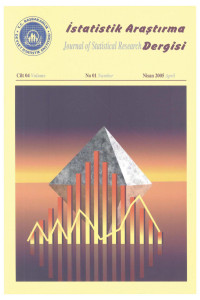Öz
The aim of this study is to construct an export expectation index (IBE) by using the questions of the Business Tendency Survey of the Central Bank of the Republic of Turkey. The most important motivation behind constructing the export expectation index is to provide an indicator of short-term export business conditions by analyzing exporters' views on general business conditions and future anticipations in the Business Tendency Survey. In constructing the export expectation index, the survey questions are chosen by the help of the cross correlation analysis and the ones that have high correlation with the export growth are combined in order to increase the reliability. To combine the selected survey questions, the weights are derived by the help of Principal Component Analysis.
Anahtar Kelimeler
Business Tendency Survey Export Cross Correlation Principal Component Analysis Kernel Function
Kaynakça
- BRY, G. ve BOSCHAN, C. (l971), Cyclical Analysis of Time Series: Selected Procedures and Computer Programs, New York, NBER, Technical Paper 20.
- CASHIN, P., MCDERMOTT, C.J. ve SCOTT, A. (1999), The Myth of Co-moving Commodity Prices, Reserve Bank of New Zealand Working Paper, No: G99/9.
- GOMEZ, V. ve MARAVALL, A. (1998), Seasonal Adjustment and Signal Extraction in Economic Time Series, Bank of Spain Working Paper, No: 9809.
- HARDING, D. ve PAGAN, A.R. (1999), Dissecting the Cycle, University of Melbourne, Melbourne Institute Working Paper, No: 13/99.
- MCDERMOTT, C.J. ve SCOTT, A. (1999), Concordance in Business Cycles, Reserve Bank of New Zealand Discussion Paper, No: G99/7.
- NILSSON, R. (1999), Business Tendency Surveys and Cyclical Analysis, Business Tendency Surveys, Proceedings of the First Joint OECD-ADB Workshop, Manila, November.
- NILSSON, R. (2003), Uses of Economic Indicators for Measuring Economic Trend, ECD/ESCAP Workshop on Composite Leading Indicators and Business Tendency Surveys, 24-26 February 2003, Bangkok.
- PAGAN, A.R. ve SOSSOUNOV, K.A. (2003), a Simple FraMework for Understanding Bull and Bear Markets, Journal of Applied Econometrics, 18(1), 23-46.
- SILVERMAN, B.W. (1986), Density Estimation for Statistics and Data Analysis, Chapman and Hall, London.
- SHARMA, S. (1996), Applied Multivariate Techniques, John Wiley and Sons, New York.
- SUTANTO, A. (1999), Business Confidence Index, Consumer Confidence Index and Index of Leading Indicators: an Experiment for Indonesia, Business Tendency Surveys, Proceedings of the First Joint OECD-ADB Workshop, Manila, November, 186-195.
Öz
İhracat yapan firmaların üst düzey yöneticilerinin bugünkü ihracat imkanlarını nasıl değerlendirdiklerinin ve geleceğe ilişkin beklentilerinin toplulaştırılmış göstergesi olması amacıyla Türkiye Cumhuriyet Merkez Bankası (TCMB) İktisadi Yönelim Anketi sorularına verilen cevaplardan yararlanılarak İhracat Beklenti Endeksi (İBE) oluşturulmuştur. Bu endeks, ihracat gelişmelerindeki ve beklentilerindeki genel eğilimi ortaya çıkararak ihracattaki büyüme hakkında önceden bilgi vermekledir. İhracat Beklenti Endeksine dahil edilecek anket sorularını seçerken çapraz korelasyon analizinden yararlanılmış, yüksek korelasyon veren soruların hangi ağırlıklarla endekse katılacağına karar vermede ise Temel Bileşenler Analizi kullanılmıştır.
Anahtar Kelimeler
İktisadi Yönelim Anketi İhracat Çapraz Korelasyon Analizi Temel Bileşenler Analizi Kernel Fonksiyonu
Kaynakça
- BRY, G. ve BOSCHAN, C. (l971), Cyclical Analysis of Time Series: Selected Procedures and Computer Programs, New York, NBER, Technical Paper 20.
- CASHIN, P., MCDERMOTT, C.J. ve SCOTT, A. (1999), The Myth of Co-moving Commodity Prices, Reserve Bank of New Zealand Working Paper, No: G99/9.
- GOMEZ, V. ve MARAVALL, A. (1998), Seasonal Adjustment and Signal Extraction in Economic Time Series, Bank of Spain Working Paper, No: 9809.
- HARDING, D. ve PAGAN, A.R. (1999), Dissecting the Cycle, University of Melbourne, Melbourne Institute Working Paper, No: 13/99.
- MCDERMOTT, C.J. ve SCOTT, A. (1999), Concordance in Business Cycles, Reserve Bank of New Zealand Discussion Paper, No: G99/7.
- NILSSON, R. (1999), Business Tendency Surveys and Cyclical Analysis, Business Tendency Surveys, Proceedings of the First Joint OECD-ADB Workshop, Manila, November.
- NILSSON, R. (2003), Uses of Economic Indicators for Measuring Economic Trend, ECD/ESCAP Workshop on Composite Leading Indicators and Business Tendency Surveys, 24-26 February 2003, Bangkok.
- PAGAN, A.R. ve SOSSOUNOV, K.A. (2003), a Simple FraMework for Understanding Bull and Bear Markets, Journal of Applied Econometrics, 18(1), 23-46.
- SILVERMAN, B.W. (1986), Density Estimation for Statistics and Data Analysis, Chapman and Hall, London.
- SHARMA, S. (1996), Applied Multivariate Techniques, John Wiley and Sons, New York.
- SUTANTO, A. (1999), Business Confidence Index, Consumer Confidence Index and Index of Leading Indicators: an Experiment for Indonesia, Business Tendency Surveys, Proceedings of the First Joint OECD-ADB Workshop, Manila, November, 186-195.
Ayrıntılar
| Birincil Dil | Türkçe |
|---|---|
| Konular | Ekonomi |
| Bölüm | Araştırma Makaleleri |
| Yazarlar | |
| Yayımlanma Tarihi | 15 Nisan 2005 |
| Yayımlandığı Sayı | Yıl 2005 Cilt: 4 Sayı: 1 |


